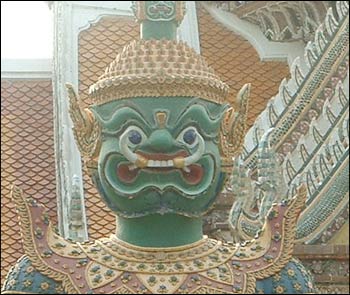
Thai Grand Royal Palace The Grand Palace for Thai is an important
symbol of Bangkok which has area more than 240,000 square-metres that visitors both Thais and foreigners always visit and worship The Emerald Buddha, the most sacred Buddha image in Thailand, in The temple of the Emerald Buddha, which adjoins on common ground.
The Grand Palace was built on time of King Rama I the Great, the first king of Chakri Dynasty, in the same time of moving the capital from Thonburi to Bangkok. The new palace was constructed to resemble Ayutthaya palace, which is destroyed since then, leaving the prosperity behind.
A lot of Thai master craftsmen at that time left their great works to The Grand Palace, especially special beautiful art objects and architecture which hard to see at anywhere in the world.
The great beauties, that visitors can see and touch, came from Thai-Brahmin believing that Thai king was god as Narain who was born to help and ward off sorrows for people. Thus, The Grand Palace was a place for king as for god and people should built it as palace in heaven.
- Outside
This area is an area for The temple of the Emerald Buddha and beautiful buildings and including constructions, art objects and architecture. The great art object of the outside is painting of Ramayana story on the wall around the temple or stone giants in front of gates (we will serve detail about The temple of the Emerald Buddha for the next time).
- Middle
This is an area for kings to stayed and to came out for checking and managing the country with ministers. There are lots of beautiful art objects and buildings such as Dusit Hall, Borombiman Hall, Amarindra Hall and Chakri Maha Prasat.
- Inside
This is forbidden area for normal people because it used to be a living place for ladies and children (if boys became 10 years old, they must moved out).
Wat Phra Kaew the Temple of the Emerald Buddha, and the adjoining Grand Palace together form perhaps the greatest spectacle for the visitor to Bangkok. Despite the fact that the whole compound is so full of tourists you spend half the time trying to avoid getting in people's photos, it's still a pretty amazing place to visit.
It consists of over 100 brightly colored buildings, golden spires and glittering mosaics, and dates back to 1782, when Bangkok was founded. When you enter the compound, you first of all see Wat Phra Kaew and the nearby attractions, and then move on to the Grand Palace afterwards.
Wat Phra Kaew itself, generally known to the Thais as Wat Phra Si Rattana Satsadaram, is perhaps the main attraction. This is Thailand's most important and sacred temple, so you're expected to act with due respect inside it. It houses the tiny (between 60 and 75 cm) Emerald Buddha, which is located high above the heads of the worshippers and tourists. Not much is known for certain about the statue, except that it isn't actually made of emerald but rather of green jade or jasper. Getting a good look at it is difficult as photography is forbidden inside the temple, and it's perched so high up inside it's glass box that it's difficult to really see.
It's thought to have been made in the 15th century and was the cause of several wars before ending up for good in Bangkok in 1782. The image is considered a talisman and holds tremendous significance for Thailand and the Thais. The 'robe' that it wears is changed 3 times each year by the King himself, at the start of each season: A diamond encrusted gold robe during the hot season, a solid gold robe in the cool season and a gilded monk's robe in the rainy season.There are also many other Buddha images inside the temple.
Round the interior walls are murals depicting the jataka stories. These are located according to the typical Thai conventions inside temples. The ones facing the altar depict the victory of  the Buddha over the evil demon Mara, as he subdues her and achieves enlightenment. As is normal for Thai temples, shoes must be taken off before entering into the temple.
the Buddha over the evil demon Mara, as he subdues her and achieves enlightenment. As is normal for Thai temples, shoes must be taken off before entering into the temple.
Despite it's national importance, Wat Phra Kaew is the only temple in Thailand that doesn't have any resident monks, and so is not a seat of Buddhist learning in the same way as the likes of Wat Pho and Wat Mahathat.
A cloister surrounds the temple, and depicted along here is an extensive mural of the Ramakian, the Thai version of the famous Indian epic, the Ramayana. In total there are 178 sections, and although they date from the reign of King Mongkut (Rama IV 1825-1850) they have since been restored on numerous occasions. The explanatory texts across from each were devised by King Chulalongkorn (Rama V).
Also in the compound is:
- A miniature model of the famous Cambodian temple complex Angkor Wat, made during the reign of King Mongkut (Rama IV) when the Thai empire extended over Cambodia.
- Two libraries, built to protect copies of important Buddhist literature. The Phra Mondop library is impressive, but almost always closed to the public. If not, it's well worth looking  at.
at.
- The impressive golden Phra Si Rattana Chedi, which it's claimed (somewhat improbably) houses ashes of the Buddha.
- The Royal Pantheon, with full size statues of the first seven kings of the reigning Chakri dynasty (Rama I - Rama VII). Only open on April 6th, the anniversary of the founding of this dynasty. Surrounding this are large statues of mythical guardians (pictured right), such as the kinaree, half human-half bird and the Hindu garuda bird. It contains the scared Buddhist scriptures, the Tripitaka.









